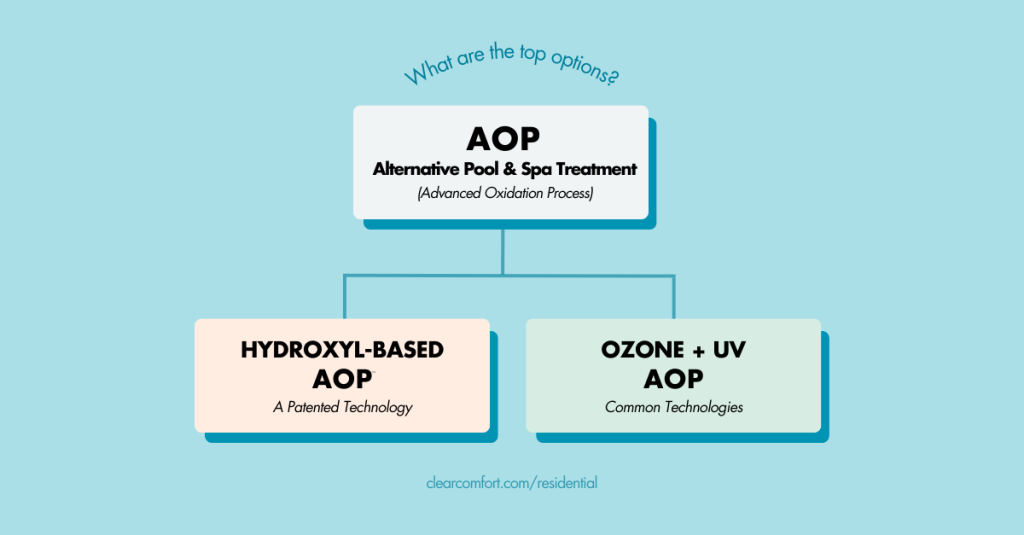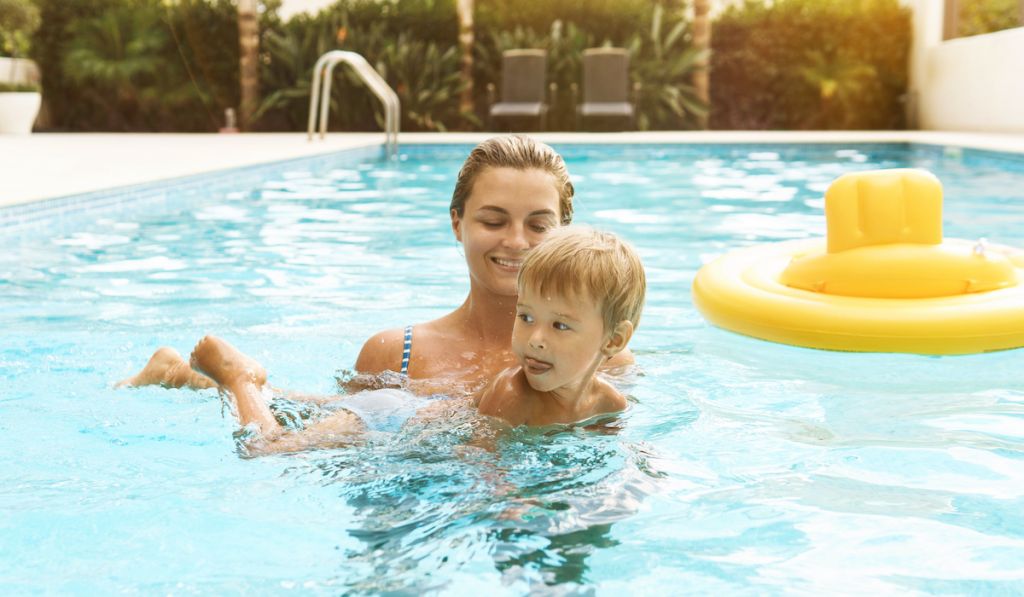If you’re looking for a healthier way to treat your home’s pool water, you’ve likely come across alternative sanitizers, like Hydroxyl-Based AOP. While names like “Hydroxyl-Based Advanced Oxidation Process” might sound complex, it’s actually an easy and effective way to have the healthiest pool water possible.
Hydroxyl-Based AOP is a patented water treatment technology that mimics our atmosphere’s air-cleaning process. Its “patented” status means it’s unique and legally protected from being copied. This patented process creates hydroxyl radicals – the most powerful oxidizers available for pool, spa and waterpark water treatment.
But what exactly are these “hydroxyl radicals”?
Hydroxyl Radicals in the Earth’s Atmosphere
Our earth’s atmosphere is like a living, breathing system. It’s where tiny hydroxyl radical molecules play a big role. According to NASA, hydroxyl radicals act as “nature’s detergent” by helping break down pollution. These radicals make the earth’s air clean and healthier to breathe.
Hydroxyl radicals (OH-) form naturally when sunlight interacts with water vapor (H2O) and oxygen (O2) in the air. In fractions of a second, hydroxyl radicals work fast, breaking down harmful pollutants, pathogens and odors. These radicals play a vital role in cleaning the air, making it fresh and safe to breathe, and greatly reducing pollution.
In short, hydroxyl radicals naturally purify our air for a healthier planet.
Hydroxyl Radicals in Pool Treatment
In today’s health-conscious world, the demand for pool treatment, or sanitation, with minimal chlorine is on the rise. In response, alternative pool approaches like AOP pool systems are becoming more popular than ever. Numerous companies have launched their own “AOP” variations with differing technologies and methods but one thing in common – hydroxyl radicals.
To understand how hydroxyl radicals work in pool treatment, let’s look at chlorine.
Why Does Chlorine Need Help From Alternatives?
Alternative pool sanitation does not replace chlorine, but it can lower the need for chlorine use. Chlorinated pool treatments, including salt water pool systems, release oxidizers that combat bacteria, algae and other contaminants. The chlorine oxidation sanitizes the water, keeping it clean and safe for swimming. However, relying only on chlorine has downsides, particularly without alternative treatment methods.
If your pool relies solely on chlorine without an alternative system, it’s more susceptible to “organics,” like lotion, sweat and oils. When these organics interact with chlorine, they create harmful “combined chlorine,” or chloramines, leading to unhealthy, cloudy and irritating pool water.
Combined chlorine the proven cause of various issues from pool water, including:
- Irritated red eyes
- Skin dryness, itchiness, redness, and pronounced eczema or dermatitis symptoms
- Lung health issues, like asthma, allergies, etc.
- “Chemical” or “pool” odor
- Damage to hair, towels and bathing suits
- Overall poor water quality
Moreover, chlorine-treated pools are prone to chlorine-resistant parasites like Cryptosporidium and Giardia. These outbreaks cause gastrointestinal issues, leading to hospitalizations and lawsuits in swimming facilities.
How Does Pool Chlorine Compare to Hydroxyl Radicals?
Chlorine, whether in traditional or saltwater forms, was the go-to pool sanitizer for decades. It’s well-known, doesn’t cost much, and works well on all sizes of water – from hot tubs to waterparks. But now, new hydroxyl-based pool treatments are reshaping the industry by addressing chlorine’s drawbacks.
Like chlorine, hydroxyl radicals are “oxidizers.” Picture those TV commercials for home cleaning products that erase tough stains on clothing. That’s oxidation at work.
Oxidation power is measured in volts. Essentially, the higher voltage, the better oxidation pool protection from bacteria, illnesses and other contaminants. Hydroxyl radicals are the most powerful oxidizer available in pool treatment, outperforming chlorine and ozone:
- Chlorine: 1.36 volts
- Ozone: 2.07 volts
- Hydroxyl radicals: 2.80 volts
With stronger oxidation power than chlorine and ozone, pool treatment relying on hydroxyl radicals can significantly reduce the need for chlorine.
What Happens When Hydroxyl Radicals Help Chlorine?
When hydroxyl radicals help chlorine oxidation, your pool needs less chlorine to keep water clean and healthy. Hydroxyl-based pool treatment, relying on hydroxyl radicals, protects swimmers from harmful combined chlorine and contaminants that chlorine or salt can’t fight off alone. This ensures your pool water isn’t just healthy, but also feels refreshing.
Unlike chlorine, hydroxyl radicals don’t linger in pool water after cleaning it. Hydroxyl radicals take less than a microsecond to oxidize contaminants in pool water – never touching swimmers or pool surfaces. With a rapid reaction time, hydroxyl radicals do not damage or corrode your pool surfaces and equipment. This is unlike chlorine-only pool systems where the chlorine oxidizer remains exposed in the pool water and organics to form harmful combined chlorine, leading to sensory irritation, odor and health issues.
Remember, alternative pool treatment should not replace chlorine, but help take the oxidation load off chlorine. By filling the gaps chlorine leaves behind, using hydroxyl-based pool treatment means less need for chlorine and other toxic chemicals. The hydroxyl pool treatment results in protected pool water that’s clear, odorless and feels fresh.
But, not every hydroxyl-based pool treatment can keep water pristine, especially with high swimmer and environmental contaminants.
Which Pool Treatment Systems Use Hydroxyl Radicals?
What’s the biggest misconception about hydroxyl radicals in pool treatment? It’s easy to find online. The common myth is that “AOP” pool systems are limited to traditional ozone and UV technologies, staples in the pool and spa industry for decades. This isn’t the case and is quickly cleared up with a bit of research.
Comparing the two is like comparing Wi-Fi and dial-up internet. They both generate hydroxyl radicals, but in two different technologies with different results and capacities.
To debunk the myths, let’s look at the top three pool treatment methods that use hydroxyl radicals: Hydroxyl-Based AOP, ozone and UV AOP pool systems, and ozone.

1. Hydroxyl-Based AOP Pool Systems
Unlike other AOP pool systems, patented Hydroxyl-Based AOP uses a science-backed process inspired by the natural way hydroxyl radicals clean the air we breathe. Being patented means Hydroxyl-Based AOP is a new, unique and one-of-a-kind technology that’s legally protected from being copied on the market. It uses the latest cutting-edge AOP technology available, and is considered a more easy and sustainable approach.
Hydroxyl-Based AOP pool systems pull in surrounding air we breathe and treat it. Inside the AOP system, those oxygen molecules are split (from O2 to O1). Then, Atomic oxygen (O1) is air-injected into plumbing and creates hydroxyl radicals by a reaction to pool water.
Using patented Hydroxyl-Based AOP to make high concentrations of hydroxyl radicals, your pool water feels like freshwater, looks crystal clear and smells odorless. It’s best fit for those with skin sensitivities, asthma and allergies. Additionally, maintaining an Hydroxyl-Based AOP system is easy, requiring only a 5-minute cartridge exchange after each year of use.
Key Features:
- Uses a patented, one-of-a-kind AOP technology
- System treats air, not water
- A dry system, with air flowing through
- Available in one form from the patent-holding manufacturer
2. Ozone + UV AOP Pool Systems
As a more common “AOP” method, Ozone + UV AOP pool systems use a two-part process that makes hydroxyl radicals in a round-about fashion. Ozone and UV pool treatment technologies have been used separately for decades, but recently have been used together to make hydroxyl radicals. First the ozone + UV AOP pool system injects ozone (O3) gas into pool plumbing. Then, the ozone + UV AOP pool system passes water over a UV lamp. Water flowing through systems can cause wear-and-tear, which can lead to repairs.
Remember, while Hydroxyl-Based AOP and ozone + UV are both “AOP”, they’re two physically-different technologies. These AOPs vary in installation, maintenance time, treatment capacities and overall results. A big difference between these two AOPs is system care.
Ozone + UV AOP pool systems need maintenance for both a UV pool system and an ozone pool system, taking up to 12 hours each year. Additionally, the energy-consuming UV lamp maintenance requires gloves, special tools and professional training.
Key Features:
- Uses a ozone and UV technologies
- System treats air via ozone and water via UV
- A wet system, with water flowing through
- Available in multiple forms from different manufacturers
3. Ozone Pool Systems
Ozone pool systems aren’t usually labeled as “hydroxyl radical” or “AOP” methods, as they rely on ozone gas and not hydroxyl radicals for oxidation. As a traditional alternative, ozone pool systems work by injecting ozone gas (O3) into the pool plumbing.
It’s possible for ozone pool systems to make hydroxyl radicals without UV, but it’s less efficient. Without a UV pool technology, ozone has a limited ability to make hydroxyl radicals by a reaction to pool water.
Again, since ozone gas is hazardous, it requires degassing to protect swimmers’ health, equipment and surfaces.
Key Features:
- Uses an ozone technology
- System treats air, not water
- A dry system, with air flowing through
- Available in multiple forms from different manufacturers
Harnessing Hydroxyl Radicals for Better Pool Water
When looking for a healthier way to treat your home’s pool water, knowing your options is key. It’s a misconception that “AOP” systems are only combinations of traditional ozone and UV technologies. But, in addition, the patented Hydroxyl-Based AOP offers an easy modern solution designed for wellness, ease and sustainability.
The top pool treatment systems that use hydroxyl radicals each offer unique benefits and maintenance needs, which is why it’s important to choose the right system for your home pool. It can be a game-changer for health- and eco-conscious pool owners.
Just as they are to the earth’s atmosphere, hydroxyl radicals are one of the best ways to keep pool water healthy, fresh and protected with little need for chlorine use.
Want to see how the different AOP types compare in water clarity? See the case study here.
Originally published in January 2018.






